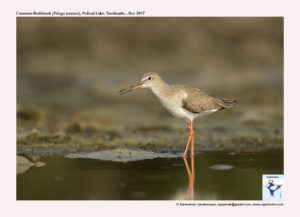Common Redshank

Common Redshank Tringa totanus
Etymology :
- Tringa : Greek word for trungas thrush-sized, white-rumped wading bird that bobs its tail, mentioned by Aristotle
- Totanus: Italian name Tótano for the Common Redshank
Vernacular Names: Hindi: Chhotabatan, Pun: Lalchaha, Mani: Ngahoibi, Mar: Chhotabataan, Surma,Guj: Ratapug, Rathapagthuthavari, Ta: Pavalakaalullan, Mali kottan, Segappukalullan, Sinh: Mahawatuwa, Mar: SamanyaTilawa
Distribution in India: Breeds in North West Himalayas and Widespread Winter visitor in India(Except Central India).
Description: Size of 27-29 cm .It has ash-brown upperparts, head and breast, streaked and spotted with black and dark brown; white secondaries conspicuous in flight. The female often has paler upperparts than male and larger than male. The non-breeding adult has greyer upperparts, without streaks or spots, but some narrow white fringes; underparts paler, breast finely streaked.
Habitat: It is found in coastal and inland wetlands, including coastal salt marshes, inland wet grasslands, grassy marshes and swampy heath lands. It breeds up to 3100 m. After breeding, found chiefly in coastal habitats including rocky, muddy and sandy shorelines, salt marshes and open mudflats, salt lakes, freshwater lagoons, salt works and sewage farms.
Food Habits: It eats insects and their larvae, especially beetles, crustaceans, annelids, molluscs, amphibians and small fish . The feeding method varies seasonally; it typical brisk walks while pecking; occasionally probes, jabs or sweeps bill through water; often wades, and occasionally swims. When feeding on fish, may forage socially in dense flock, often mixed with other tringines: birds move erratically while pecking at prey or running synchronously in one direction, ploughing or scything bills through water. It feeds diurnally and nocturnally. Mostly in small flocks,sometimes singly.
Breeding Habits: They breed in April-July in Himalayas, Iceland, Scandinavia and North Sea.They are monogamous. The nest is typically at base of tall clump of grass within generally taller vegetation, with leaves covering overhead, constructed by female.They lay a clutch of 3–5 eggs, with laying interval of 35-43 hours. The incubation period is 22–29 days. Incubation is done by both sexes, starting with final egg.The brood is split between the parents before fledging; fledging period is 25–35 days.